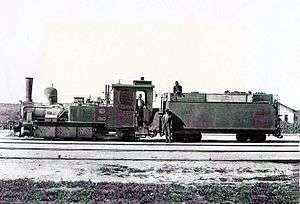South West African Class Hb
|
No. 61 with optional coal and water tender, c. 1930 | |||||||||||||||||||||||||||||||||||||||||||||||||||||||||
| |||||||||||||||||||||||||||||||||||||||||||||||||||||||||
| |||||||||||||||||||||||||||||||||||||||||||||||||||||||||
| |||||||||||||||||||||||||||||||||||||||||||||||||||||||||
| |||||||||||||||||||||||||||||||||||||||||||||||||||||||||
The South West African Class Hb 0-6-2T of 1905 was a narrow gauge steam locomotive from the Deutsch-Südwest-Afrika era.
Between 1905 and 1908, the German Administration in Deutsch-Südwest-Afrika acquired fifteen Class Hb tank locomotives with a 0-6-2 wheel arrangement, for lease to the Otavi Mining and Railway Company. Six of these locomotives survived to be taken onto the roster of the South African Railways after the First World War.[1][2][3]
Manufacturer
By 1905, the rapid progress with the construction of the Otavi Railway called for heavier and more powerful locomotives. Between 1905 and 1908, fifteen 600 millimetres (23.6 inches) narrow gauge 0-6-2 tank and tank-and-tender steam locomotives were built for the German Administration in Deutsch-Südwest-Afrika (DSWA) by Henschel and Son in Germany. They were designated Class Hb and numbered in the range from 51 to 65.[1][3][4]
The locomotives were leased to the Otavi Mining and Railway Company, who operated the narrow gauge Otavi Railway which was being constructed across the Namib Desert between Swakopmund and Tsumeb, to augment their mainline locomotive fleet.[1][3]
Characteristics
The locomotives used Allan valve gear and were equipped with dust covers to protect the motion from wind-blown sand in the Namib Desert. The "Hb" classification identified the locomotive type as the second class to have been built for DSWA by Henschel. They were delivered in four batches.[1][4]
- The first three tank locomotives were delivered in 1905, with works numbers in the range from 7298 to 7300 and numbered in the range from 51 to 53.[4]
- Four more followed in 1906, with works numbers in the range from 7623 to 7626 and numbered in the range from 54 to 57.[4]
- Two arrived in 1907, with works numbers 8610 and 8611 and numbered 64 and 65.[4]
- Six were delivered in 1908, with works numbers in the range from 7740 to 7745 and numbered in the range from 58 to 63. These last six locomotives were delivered as tank-and-tender engines, equipped with optional coal and water tenders.[4]
South African Railways
During the First World War, the former German Colony came under South African administration and the railways in DSWA came under control of the Union Defence Forces. Control of all railway operations in South West Africa (SWA) was passed on from the Military to the Director of Railways in Windhoek on 1 August 1915. On 1 April 1922, all the railway lines and rolling stock in the territory became part of the South African Railways (SAR).[1][3]

Six of these locomotives, numbers 51, 54, 56, 61, 62 and 65, survived into the SAR era. They retained their German Colonial Hb classification and engine numbers while in SAR service. They were withdrawn from service in 1942 and all but one were scrapped.[1][2][3]
Photographic evidence, such as that of no. 56 alongside, suggests that at some stage, probably in the SAR era, the surviving locomotives were made into tender engines by removing their side tanks. This particular locomotive has been preserved, coupled to a short period train at the Alte Feste museum in Windhoek.[2]
References
- 1 2 3 4 5 6 Paxton, Leith; Bourne, David (1985). Locomotives of the South African Railways (1st ed.). Cape Town: Struik. p. 116. ISBN 0869772112.
- 1 2 3 Dulez, Jean A. (2012). Railways of Southern Africa 150 Years (Commemorating One Hundred and Fifty Years of Railways on the Sub-Continent - Complete Motive Power Classifications and Famous Trains - 1860-2011) (1st ed.). Garden View, Johannesburg, South Africa: Vidrail Productions. pp. 235, 387. ISBN 9 780620 512282.
- 1 2 3 4 5 Espitalier, T.J.; Day, W.A.J. (1947). The Locomotive in South Africa - A Brief History of Railway Development. Chapter VII - South African Railways (Continued). South African Railways and Harbours Magazine, October 1947. p. 859.
- 1 2 3 4 5 6 Henschel-Lieferliste (Henschel & Son works list), compiled by Dietmar Stresow
| Wikimedia Commons has media related to South African Class Hb (0-6-2). |
